HP Victus 16 (2021) Review
Is this affordable gaming laptop too good to be true?
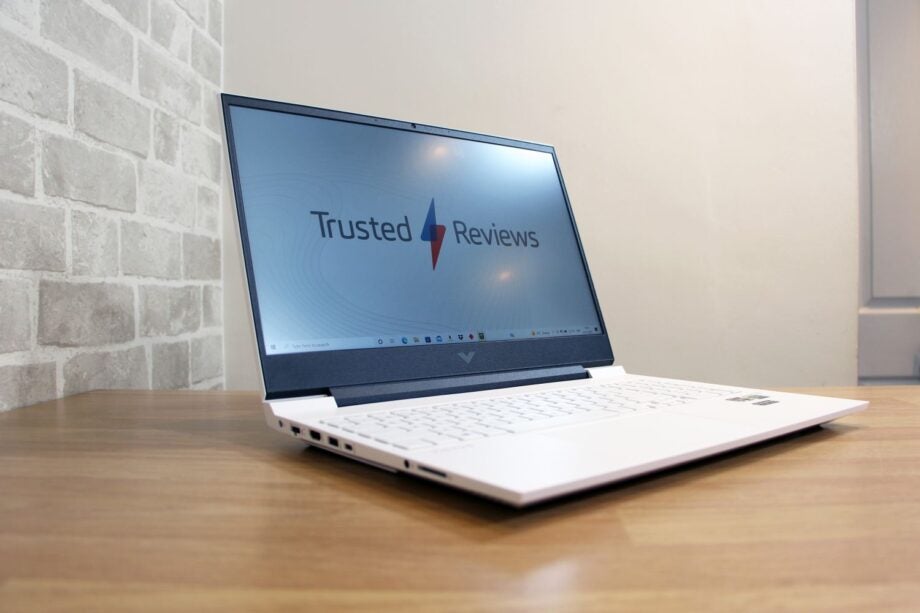
Verdict
The HP Victus 16 is an affordable and effective option for mainstream gaming. The graphics chip and processor both impress, the 16.1in display increases immersion, and the keyboard is reasonable. However, don’t expect lashings of pace, good screen quality or a particularly high refresh rate.
Pros
- Rock-solid mainstream gaming power
- Impressive AMD Ryzen 7 CPU
- Cheaper than the competition
- Quieter than most gaming laptops
Cons
- Bland, washed-out display
- Mediocre connectivity
- Irritating power button
Availability
- UKRRP: £1049
- USARRP: $1599
- EuropeRRP: €1299
Key Features
- Good components for everyday useThe Nvidia GeForce RTX 3060 is a rock-solid mainstream gaming chip, and the AMD Ryzen 7 5800H is a superb processor for almost all work scenarios
- A 16:10 displayThe 16.1in display here is a fraction larger than the screen included on 15.6in laptops, so it’s a bit more absorbing
- Decent battery lifeThe HP’s battery lasts for almost all day if you’re not playing games, which makes this notebook more versatile
Introduction
The HP Victus 16 is the first laptop I’ve seen from HP’s new gaming brand, and it’s designed to be a more affordable and subdued option next to the company’s high-end Omen range.
The Victus impresses for some of its pricing. This rig might include powerful hardware such as an Nvidia GeForce RTX 3060 and AMD Ryzen 7 5800H, but in the UK and Europe it costs just £1049 and €1299 – which makes it one of the best deals around. In the US expect to pay $1599, which is a more moderate price.
Decent components are paired with a 16.1in display that HP reckons will provide extra immersion compared to 15.6in panels – which is ideal if you don’t want a huge 17.3in machine.
And while such 16.1in machines are relatively rare, the HP Victus 16 still faces plenty of competition from conventional 15.6in models.
The Dell G15 is also a mainstream gaming laptop with an RTX 3060 and an AMD processor, and it costs £1089 / €1299 / $1519, and you can get the Lenovo Legion 5 with the same hardware for £1199 / €1537 / $1379. The third option is the MSI Katana GF66, which pairs an RTX 3060 with an Intel Core i7 processor for £1099 / €1299 / $1299.
Design and Keyboard
- Good looks, but mediocre build quality and dimensions
- Solid connectivity, but the HP would benefit from faster USB ports
- A snappy, crisp keyboard with some irritating layout decisions
The model of Victus reviewed here is the white one – blue and black are also available – and it impresses with a sleek V-shaped logo, some “designed by HP” text on the hinge and attractive speaker vents. It looks better than the plain Lenovo and MSI machines, and on a par with the Dell.
Once hands-on, though, some more ordinary design came to the fore. One such area is build quality. If you push the back of the HP’s panel, desktop distortion is clearly visible; there’s obvious movement in the wrist-rest and keyboard, and the machine rattles, too. Note that this is an all-plastic build, with no metal used on the outside.
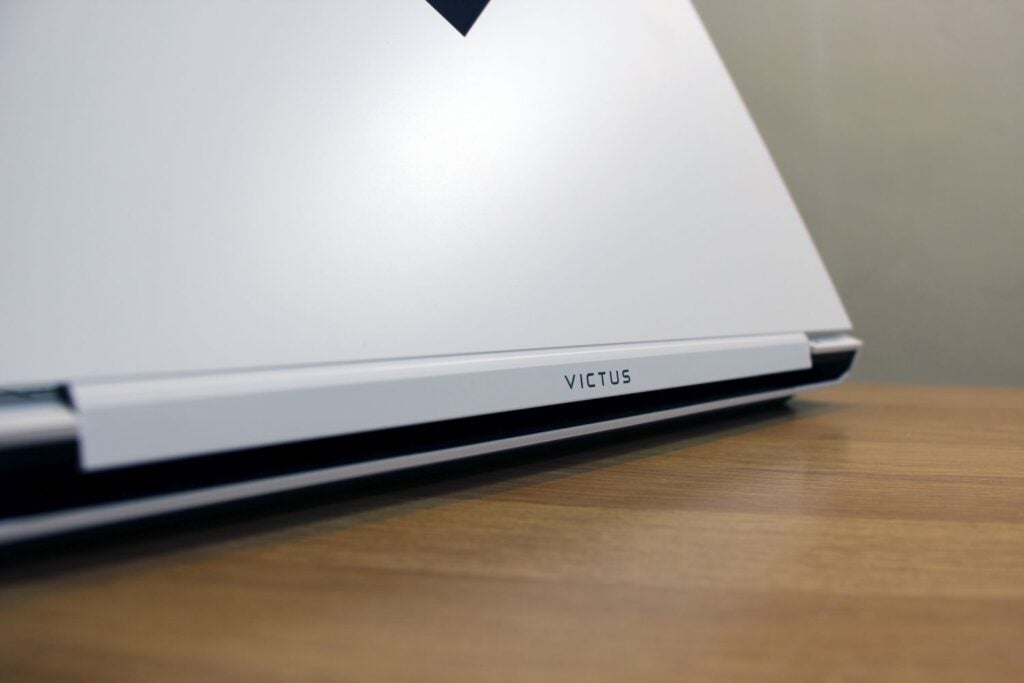
The HP’s build quality isn’t terrible, but its mediocre strength means its rivals feel more robust. At 2.5kg, the Victus is a tad heavier than every competitor, too, even if the 23.5mm body does make it a bit slimmer.
Elsewhere, the Victus is mediocre, with three USB ports and one Type-C connection that handles DisplayPort, but no faster USB connections and no sign of Thunderbolt. At least a card reader and Ethernet does features, as does an HDMI output.
On the inside, dual-band Wi-Fi 6 and Bluetooth handle connectivity. The HP has a webcam, but it doesn’t support Windows Hello. The speakers are loud and have a clear mid-range, but they lack bass, with high-pitched noises sounding tinny. Although these speakers are fine for everyday games, they sound toothless; a headset will be better.
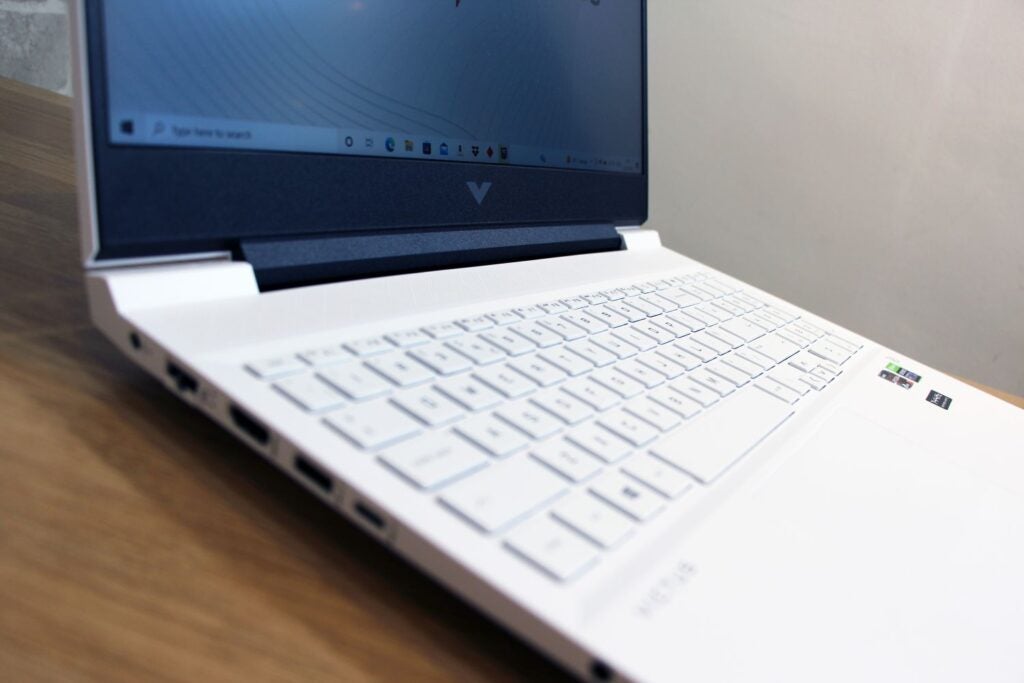
The keyboard, too, is a mixed bag. The buttons are snappy, quick, and quiet, without the softness that can afflict more affordable notebooks – if you want a crisp gaming experience, the Victus delivers. This machine has a numberpad and a dedicated button to open the HP Omen gaming app.
However, there’s no RGB LED backlighting, the cursor keys are small, and the power button is crammed in between the F12, Backspace and Delete keys. The button does require a little more force to register than those around it, but it’s too easy to hit during a gaming session. Its placement is terrible. The touchpad, too, is only average – it rattles and pushes down too far. I’d recommend using a USB mouse instead.
Screen
- The 16.1in diagonal delivers a marginally better experience than 15.6in panels
- The panel suffers a lack of brightness and a narrow colour gamut
- It’s fine for mainstream gaming, but pricier portables will be far better
There’s only half an inch between the HP’s 16.1in display and those included on 15.6in rivals, but the extra width is noticeable. While it won’t transform gameplay, a bigger screen is always nice to have – if your potential portable choices are too close to call, then you may as well opt for the laptop with the larger screen.
The Victus’ panel retains a 1920 x 1080 resolution rather than going any higher, and this screen has a 144Hz refresh rate that delivers smooth motion in all single-player games and in mainstream eSports scenarios.
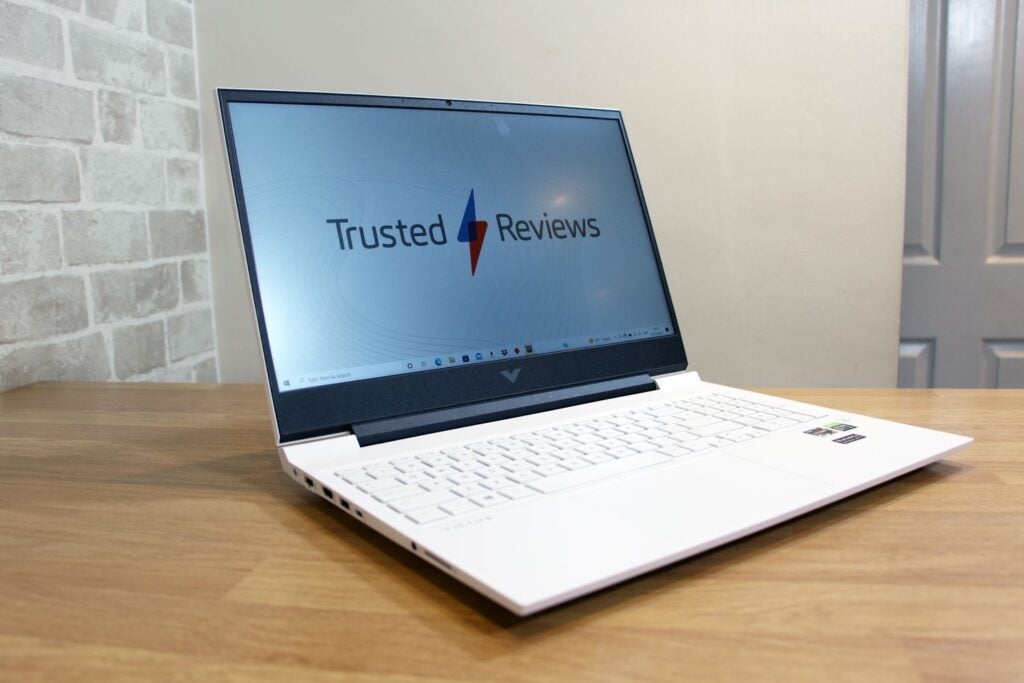
HP has dropped the ball when it comes to quality, though. This machine’s peak brightness level of 240 nits makes this panel only good enough to use indoors – even then it may struggle under particularly bright lights. The Delta E of 4.9 is also distinctly mediocre. The panel rendered only 58.8% of the sRGB colour gamut, which means that this screen simply can’t render a number of the shades that mainstream games require.
The screen’s black point of 0.14 nits is decent and delivers a great contrast ratio of 1714:1, which means the panel does a decent job of producing depth – but that’s little comfort considering my other results. The poor brightness and narrow band of colours mean that games look washed-out and bland on this panel.
For everyday gaming the HP is fine, and its rivals suffered similarly – the Dell and MSI machines suffered poor gamut handling and the Lenovo delivered underwhelming contrast. You’ll have to spend more to solve these problems.
Performance
- The RTX 3060 will handle any single-player and eSports game
- The eight-core AMD CPU is a rock-solid content-creation choice
- HP’s machine is quieter than most gaming laptops, even when pushed
The HP pairs an AMD Ryzen 7 5800H processor with an Nvidia GeForce RTX 3060 6GB graphics chip. They’re impressive components that can handle everyday tasks with ease. HP has configured them with mid-range specifications: the eight-core 5800H has a power limit of 45W, which sits in the middle of the chip’s power range, and the graphics core runs at 95W, short of its potential 115W peak.
The rest of the HP’s components are solid. There’s 16GB of dual-channel memory clocked to 3200MHz, and an SSD with reasonable read and write speeds of 3258MB/s and 2784MB/s – good enough to keep the laptop feeling snappy. The SSD’s 512GB capacity will disappoint if you want to install lots of games, but at least there’s a spare bay on the inside for an easy upgrade.
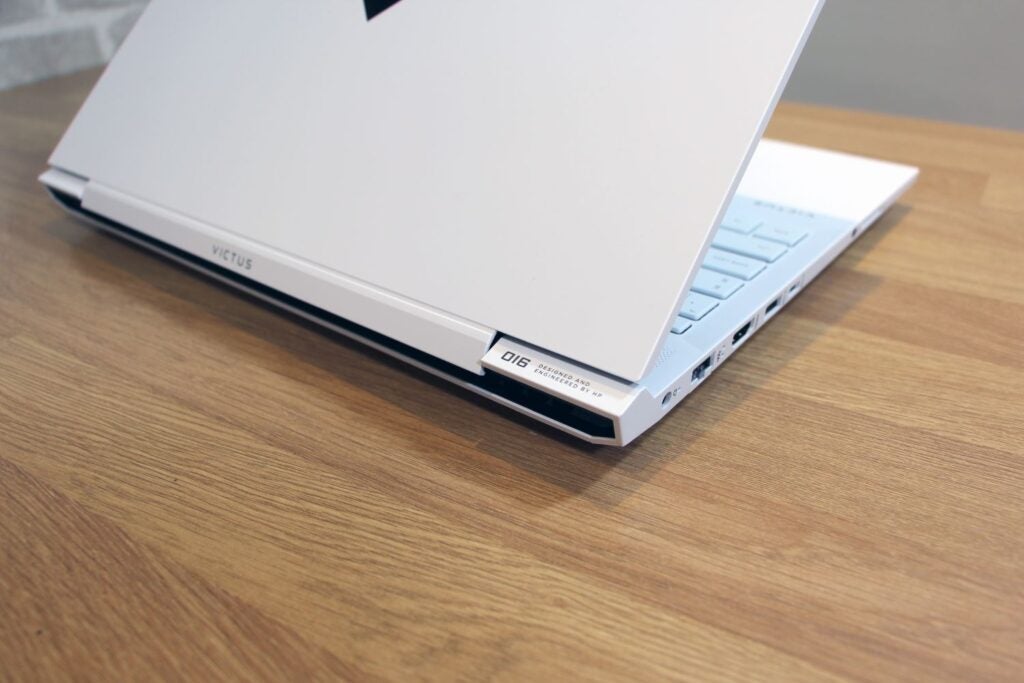
The mid-range RTX 3060 produced good pace in games benchmarks. With Horizon: Zero Dawn running at Ultimate settings at 1080p, the HP averaged a smooth 78fps. It played Borderlands 3 at 62fps. This laptop will run any single-player game well without graphics compromise and with ray tracing and DLSS.
The HP is a solid options for eSports, too – its average of 248fps in Rainbow Six Siege proves that you can run any competitive title at the pace required to make full use of the 144Hz display.
HP’s machine has clear lead over the MSI Katana, which ran the RTX 3060 at 85W – that laptop was four and five frames slower respectively in Horizon and Borderlands too. The Victus competed well with the 125W GPU inside the Dell, too. That machine only hit 77fps in Horizon, and the HP’s Performance mode improved its Borderlands score to 67fps – level with the Dell.
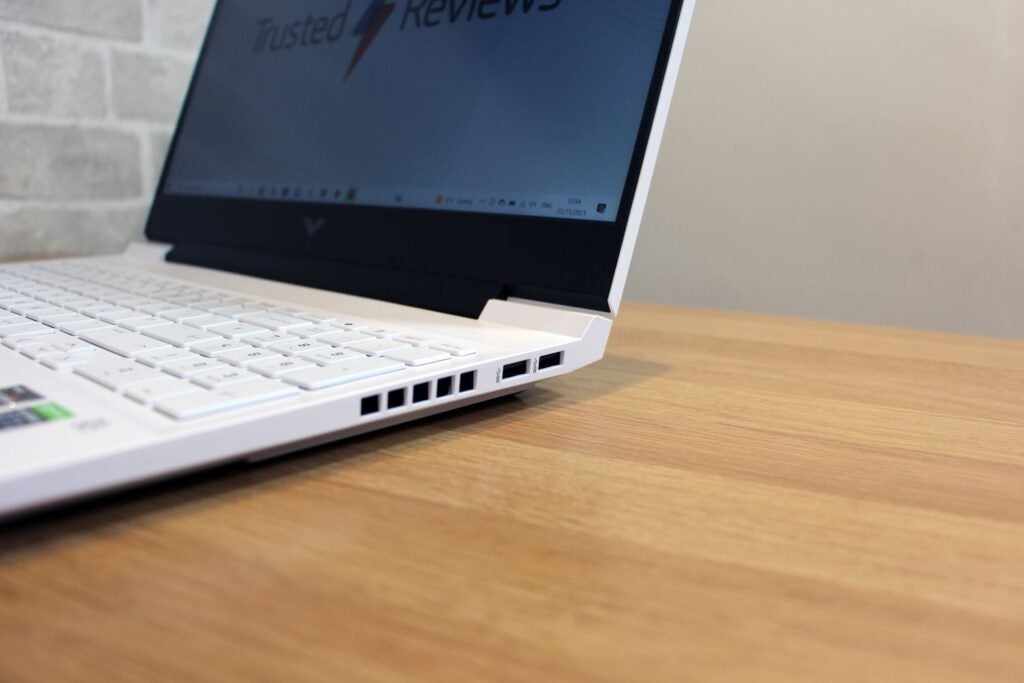
Don’t expect infallible performance gains from Performance mode, though: it reduced the HP’s Rainbow Six Siege score, while increasing noise output. The HP has a Quiet mode, too, but that option is only suitable for eSports and casual games, and it doesn’t keep up with the 144Hz panel.
The Ryzen 7 processor is consistently great. In Geekbench’s multi-core test the HP laptop scored 8039, which is faster than the Lenovo and Dell machines – even though both of those use the same chip. The Victus’ PCMark 10 score of 6639 was competitive, too, and there’s little to choose between the HP’s single-core Geekbench test when lined up with rivals.
This processor will handle mainstream photo- and video-editing alongside other content-creation tools, and it will scythe through every Office application without breaking a sweat. It’s great at multi-tasking, and easily outpaced the Core i7 chip used in the MSI – that CPU only hit 6556 in the Geekbench multi-core test. You only need more power if you want to tackle really tough work.
HP’s machine performed well in thermal tests, too. When the laptop ran games in its Standard mode, the fan output proved quieter than the majority of gaming laptops, and modest enough that the speakers could drown out the noise. The Victus was only slightly louder in Performance mode. Ultimately, this laptop is pretty quiet for a gaming machine.
If you want to use this laptop for work, expect solid speeds with only slight throttling. In Standard and Performance modes, the processor ran with single- and multi-core speeds of 4.3GHz and 3.6GHz, which isn’t far off the chip’s theoretical pace. In Quiet mode, the chip ducked down to 2.9GHz.
The processor did ratchet up to 99 degrees before throttling in Performance mode, but the chip’s speeds weren’t severely hindered; that was my only thermal issue. Impressively, very little of the HP’s heat made it to the outside – the external panels remained relatively cool.
Battery
- Middling gaming performance – don’t expect more than 90 minutes
- HP’s machine lasts longer than some rivals in other tests
If you want to use the HP to play games, then expect the battery to last for 90 minutes. This isn’t unusual for a gaming laptop, and it sits right between the Dell and Lenovo models.
In other scenarios, the HP was better. It lasted for just over seven hours when working and just shy of eight hours while playing a video. That’s impressive for a machine with this level of hardware, and it’s longer than the MSI and Lenovo machines.
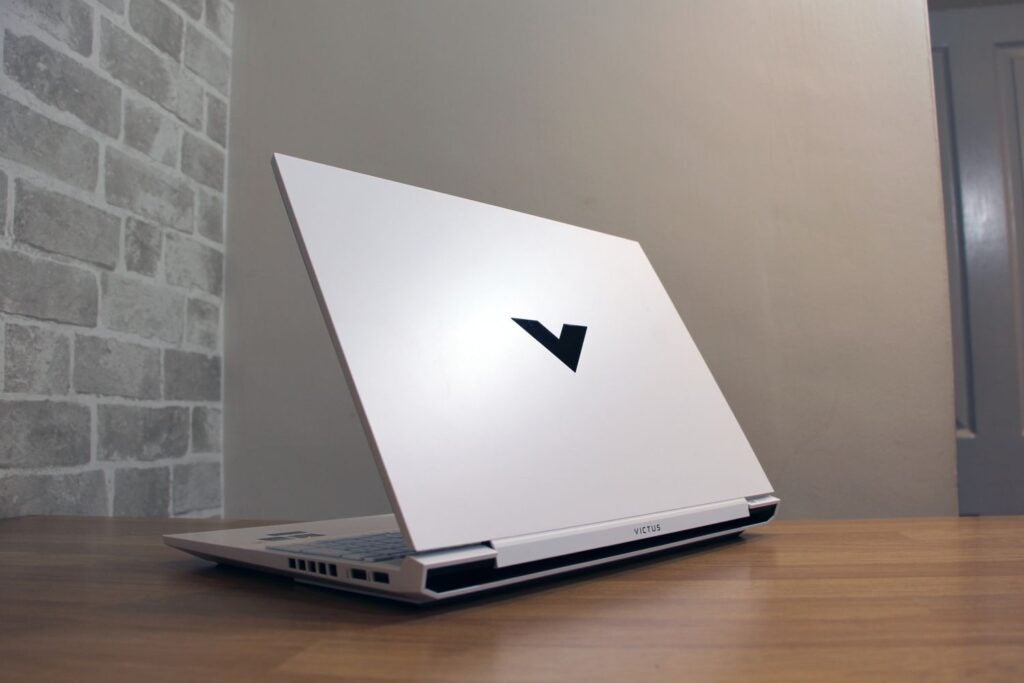
However, the Dell remains the undisputed winner for good battery life: that laptop lasted for nearly two hours when gaming and nearly 10 hours when working, making it the only genuine all-day option mentioned here.
Latest deals
Should you buy it?
You’d like an affordable laptop for mainstream gaming:
The HP pairs its great price with rock-solid 1080p gaming performance, and the 16.1in display makes games more immersive, too.
You need something slim, light or ideal for eSports:
The HP isn’t the smallest notebook, and its 144Hz refresh rate is fine for everyday games but not good enough for high-end eSports.
Final Thoughts
The HP Victus 16 is a good option for everyday gaming if you don’t want to spend lots of money; the RTX 3060, AMD Ryzen 7 5800H and 16.1in screen see to that. But the budget bites elsewhere, with disappointing colour quality from the display and a chassis that’s heavy and a bit too weak.
How we test
Every gaming laptop we review goes through a series of uniform checks designed to gauge key things including build quality, performance, screen quality and battery life.
These include formal synthetic benchmarks and scripted tests, plus a series of real world checks, such as how well it runs when running a AAA game.
We used as our main laptop for at least a week.
Tested the performance via both benchmark tests and real-world use.
We tested the screen with a colorimeter and real-world use.
We tested the battery with a benchmark test and real-world use.
FAQs
The HP Victus 16 comes with a one-year warranty; extensions are available for an extra fee.
Yes, the HP Victus 16 does feature a webcam.
Yes, this is a gaming laptop and posted great results at a 1080p performance.








